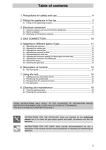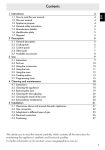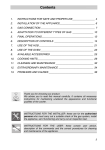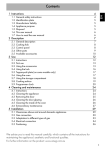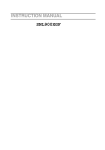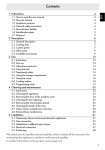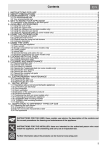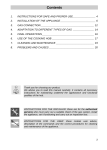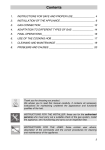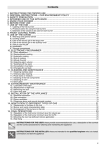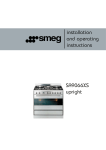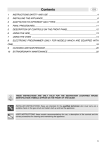Download Smeg SA9058X Instruction Manual
Transcript
Contents 1 INSTRUCTIONS SAFETY AND USE _________________________________________4 2 INSTRUCTIONS FOR DISPOSAL – OUR ENVIROMENTAL CARE _________________6 3 INSTALLATION OF THE APPLIANCE ________________________________________7 4 ADAPTATION TO DIFFERENT GAS TYPES __________________________________11 5 FINAL PROCEDURES____________________________________________________13 6 DESCRIPTION OF CONTROLS ON THE FRONT PANEL________________________14 7 USING THE HOB________________________________________________________16 8 USING THE OVEN ______________________________________________________17 9 ELECTRONIC PROGRAMMER (ONLY FOR MODELS WHICH ARE EQUIPPED WITH ONE)______________________________________________________________________19 10 AVAILABLE ACCESSORIES_______________________________________________21 11 CLEANING AND MAINTENANCE ___________________________________________22 12 EXTRAORDINARY MAINTENANCE _________________________________________24 THESE INSTRUCTIONS ARE ONLY VALID FOR THE DESTINATION COUNTRIES WHOSE IDENTIFICATION SYMBOLS APPEAR ON THE FRONT OF THIS GUIDE. INSTALLER INSTRUCTIONS: these are intended for the qualified technician who must carry out a suitable check on the gas circuit and install, start up and test the appliance. USER INSTRUCTIONS: these contain recommendations for use, a description of the controls and the correct procedures for cleaning and maintaining the appliance. 3 Introduction 1 INSTRUCTIONS SAFETY AND USE THIS GUIDE IS AN INTEGRAL PART OF THE APPLIANCE. IT SHOULD BE KEPT IN A SAFE PLACE WITHIN EASY REACH THROUGHOUT THE LIFE CYCLE OF THE COOKING RANGE. WE RECOMMEND THAT YOU READ THIS GUIDE CAREFULLY TOGETHER WITH ALL THE INSTRUCTIONS GIVEN BEFORE USING THE COOKING RANGE. ENSURE YOU ALSO KEEP THE INJECTORS PROVIDED WITH THE APPLIANCE. THE APPLIANCE MUST BE INSTALLED BY QUALIFIED PERSONNEL AND IN ACCORDANCE WITH THE APPLICABLE LEGISLATION. THIS APPLIANCE IS INTENDED FOR DOMESTIC USE ONLY AND IT MEETS THE REGULATIONS IN FORCE. THE APPLIANCE HAS BEEN DESIGNED TO CARRY OUT THE FOLLOWING FUNCTION: COOKING AND HEATING FOOD; IT IS NOT SUITABLE FOR ANY OTHER USE. THE MANUFACTURER DOES NOT ACCEPT ANY RESPONSIBILITY IN THE EVENT THAT THE COOKING RANGE IS USED OTHER THAN AS INDICATED IN THIS GUIDE. DO NOT DISCARD THE PACKAGING IN THE HOME ENVIRONMENT. SEPARATE THE VARIOUS PACKAGING MATERIALS AND TAKE THEM TO YOUR NEAREST COLLECTION CENTRE. THE APPLIANCE MUST BE EARTHED IN COMPLIANCE WITH THE ELECTRICAL SYSTEM SAFETY REGULATIONS. THE PLUG TO BE ATTACHED TO THE SUPPLY CABLE AND THE CORRESPONDING SOCKET MUST BE THE SAME TYPE AND MUST MEET THE REGULATIONS IN FORCE. THE SOCKET MUST BE ACCESSIBLE ONCE THE APPLIANCE HAS BEEN FITTED IN PLACE. NEVER REMOVE THE PLUG FROM THE ELECTRICAL SUPPLY BY PULLING ON THE CABLE. AFTER INSTALLATION, CHECK THE APPLIANCE IN ACCORDANCE WITH THE INSTRUCTIONS GIVEN BELOW. IF IT IS NOT OPERATING PROPERLY, TURN OFF THE ELECTRICAL SUPPLY TO THE APPLIANCE AND CONTACT YOUR NEAREST AFTER-SALES SERVICE. NEVER ATTEMPT TO REPAIR THE APPLIANCE YOURSELF. EVERY TIME YOU FINISH USING THE APPLIANCE, MAKE SURE THAT THE CONTROL KNOBS ARE SET TO (OFF). NEVER PUT FLAMMABLE OBJECTS INSIDE THE OVEN: IN THE EVENT OF AN ACCIDENTAL SWITCH-ON, THIS COULD LEAD TO FIRE. THE ID PLATE CONTAINING ALL THE TECHNICAL DATA, THE SERIAL NUMBER AND BRAND NAME IS AFFIXED INSIDE THE STORAGE COMPARTMENT. DO NOT REMOVE THIS PLATE FOR ANY REASON. DO NOT PUT SAUCEPANS ON THE HOB RACKS UNLESS THEIR BASES ARE PERFECTLY FLAT AND EVEN. 4 Introduction DO NOT USE COOKWARE OR BAKING TRAYS WHICH ARE LARGER THAN THE HOB. WHEN LOWERING THE GLASS COVER ONTO THE HOB, KEEP HOLD OF IT WITH YOUR HAND (THE COVER IS ONLY AVAILABLE WITH CERTAIN MODELS). ATTENTION: THE GLASS COVER MAY BREAK IF IT IS OVERHEATED. TURN OFF ALL BURNERS AND WAIT UNTIL THEY COOL DOWN BEFORE CLOSING IT. DURING USE, THE APPLIANCE BECOMES VERY HOT. PLEASE ENSURE THAT YOU DO NOT TOUCH THE HEATING ELEMENTS INSIDE THE OVEN. THE APPLIANCE IS INTENDED FOR USE BY ADULTS ONLY. DO NOT ALLOW CHILDREN TO PLAY WITH THE APPLIANCE. WHEN THE GRILL IS IN OPERATION, THE ACCESSIBLE PARTS OF IT CAN BECOME VERY HOT: KEEP CHILDREN AT A SAFE DISTANCE. IF THE APPLIANCE IS PLACED ON A SUPPORT, IT MUST BE INSTALLED IN SUCH A WAY THAT IT DOES NOT SLIDE OFF THE SUPPORT. THIS APPLIANCE HAS BEEN MARKED IN ACCORDANCE WITH EUROPEAN DIRECTIVE 2002/96/EC ON WASTE ELECTRICAL AND ELECTRONIC EQUIPMENT (WEEE). THE DIRECTIVE SETS OUT THE FRAMEWORK FOR COLLECTION AND RECOVERY OF WASTE EQUIPMENT AS APPLICABLE WITHIN THE EC MEMBER STATES. BEFORE STARTING UP THE APPLIANCE, ALL LABELS AND PROTECTIVE FILMS BOTH INSIDE AND OUTSIDE THE APPLIANCE MUST BE REMOVED. THE MANUFACTURER DOES NOT ACCEPT ANY RESPONSIBILITY FOR DAMAGE TO PERSONS OR PROPERTY RESULTING FROM A FAILURE TO RESPECT THE REQUIREMENTS SET OUT ABOVE, FROM ANY ALTERATION MADE TO ANY PART OF THE APPLIANCE OR FROM THE USE OF NON-ORIGINAL SPARE PARTS. 5 Instructions for disposal 2 INSTRUCTIONS FOR DISPOSAL – OUR ENVIROMENTAL CARE Our product's packing is made of non-polluting materials, therefore compatible with the environment and recyclable. Please help by disposing of the packing correctly. Find the addresses of collection, recycling and disposal centres from your retailer or from the competent local organisations. Do not throw the packing or any part of it away. They can constitute a suffocation hazard for children, especially the plastic bags. Your old appliance also needs to be disposed of correctly. Important: hand over your appliance to the local agency authorised for the collection of household appliances no longer in use. Correct disposal means intelligent recycling of valuable materials. It is also necessary to cut the interconnecting cable to the power supply network, removing it along with the plug. DO NOT DISCARD PACKING IN THE HOME ENVIRONMENT. SEPARATE THE VARIOUS WASTE MATERIALS AND TAKE THEM TO THE NEAREST SELECTIVE WASTE COLLECTION CENTRE. 6 Instructions for the installer 3 INSTALLATION OF THE APPLIANCE It is the law that all gas appliances are installed by authorised persons. Clearance around the cooker must comply with the requirements of AS5601. 3.1 Electrical connection Make sure that the power line voltage matches the specifications indicated on the rating plate located inside the storage compartment. This rating plate must never be removed. On the power line, install a two-pole cut-off device with contact cut-off distance greater than or equal to 3 mm, located in an easily accessible position near the unit. The wire section on the cable must not be less than 1.5 mm2 (3 x 1.5 cable), keeping in mind that the end to be connected to the cooker must have the ground wire (yellow-green) longer by at least 20 mm. Use only the special cables available at our Service Centres. The manufacturer declines all responsibility for damage to persons or things caused by nonobservance of the above prescriptions or by interference with any part of the appliance. Overall dimensions: location of gas and electrical connection points (all measures in mm). 900 A B C D 100 660 160 220 750 A B D C 7 Instructions for the installer 3.2 Gas connection This appliance is suitable for installation with Natural Gas or ULPG (propane). Refer to page 13 for the relevant burner pressure and appropriate injector sizes. When the appliance is to be connected to Natural Gas then the pressure regulator supplied must be fitted to the gas inlet. A test point (for checking the gas pressure) is supplied either with the regulator or as a separate fitting in the case of LPG (propane) appliances. Connection of the appliance to the gas supply must be in accordance with the requirements of AS5601. A ½” BSP connector at the inlet is recommended and the gas supply line to the appliance must be of adequate length to allow sufficient withdrawal of appliance for service or disconnection and be: 1. annealed copper pipe or; 2. Flexible hose according to AS/NZ1869 & be at least Class “B”, 10 mm diameter, max length 100 mm. The cooker must be installed with provision to allow the gas to be turned off and disconnected for servicing and removal of the appliance as required from the gas supply. Before the cooker is operated make certain all relevant parts are placed in the correct position. When the installation is completed the installation connections of cooker will require to be leak tested, the burner operating pressure and flame checked and adjusted. Warranty service calls do not cover these adjustments! To check the operating pressure of the appliance it is recommended at least 2 large size burners are used. Ensure appliance is secured to wall when installation is completed. N.G. The regulator supplied must be fitted to the ½ BSP thread at the rear of the appliance. An approved manual shut-off valve must be installed. The N.G. regulator must be checked and adjusted to 1.0kPa after installation. U.L.P.G. Can be connected to the inlet fitting directly. The pressure must be checked to ensure it is operating at 2.75kPa. A separate test point fitting must be installed between the piping & the appliance for the pressure to be checked to ensure it is operating at 2.75kPa. 8 Instructions for the installer 3.3 Room ventilation The appliance may only be installed in constantly ventilated rooms, in accordance with the regulations in force. The room where the appliance is installed must provide sufficient air for frequent gas combustion and the renewal of the air in the room. The air intakes, which are protected by grates, must be of a suitable size (in accordance with the regulations in force) and be placed where they cannot be obstructed either wholly or partially. The openings must enable 2 m3/h of air to enter per kW of gas power of the appliance. The kitchen must be suitably ventilated in order to eliminate the heat and humidity produced by cooking. In particular, after extended use, you are advised to open a window or step up the speed of any fans in use. 3.4 Discharge of combustion products Combustion products must be discharged by means of a hood connected to a reliable naturally drawing chimney or one using forced suction. An effective suction system must be carefully designed by a specialist, respecting the positions and distances set out in the relevant regulation. When the installation is complete, the installer must provide a certificate of conformity. 9 Instructions for the installer 3.5 Clearance above and around domestic cookers Extract from AS5601 REQUIREMENTS 1 Overhead clearances – (Measurement A) Range hoods and exhaust fans shall be installed in accordance with the manufacturer’s instructions. However, in no case shall the clearance between the highest part of the hob of the cooking appliance and a range hood be less than 600 mm or, for an overhead exhaust fan, 750 mm. Any other downward facing combustible surface less than 600 mm above the highest part of the hob shall be protected for the full width and depth of the cooking surface area in accordance with Clause 5.12.1.2. However, in no case shall this clearance to any surface be less than 450 mm. 2 Side clearances – (Measurements B & C) Where B, measured from the periphery of the nearest burner to any vertical combustible surface, is less than 200 mm, the surface shall be protected in accordance with Clause 5.12.1.2 to a height C of not less than 150 mm above the hob for the full dimension (width or depth) of the cooking surface area. Where the cooking appliance is fitted with a ‘splashback’, protection of the rear wall is not required. 3 Additional requirements for Freestanding and Elevated Cooking Appliaces – (Measurements D & E) Where D, the distance from the periphery of the nearest burner to a horizontal combustible surface is less than 200 mm, then E shall be 10 mm or more, or the horizontal surface shall be above the trivet. See insets above. NOTES 1 Requirement 3 does not apply to a freestanding or elevated cooking appliance which is designed to prevent flames or the cooking vessels from extending beyond the periphery of the appliance. 2 The ‘cooking surface area’ is defined as that part of the appliance where cooking normally takes place and does not include those parts of the appliance containing control knobs. 3 For definition of hob, see Clause 1.4.64. 4 For definition of trivet, see Clause 1.4.109. 5 Consideration is to be given to window treatments when located near cooking appliances. See Clause 5.3.4. 10 Instructions for the installer 4 ADAPTATION TO DIFFERENT GAS TYPES Before carrying out any procedure, cut the electrical supply to the appliance. The cooking range hob is set to use natural gas G20/G25 (2E+) at a pressure of 20/25 mbars in cooking ranges with a large oven, and butane/propane gas G30/G31 (3+) at a pressure of 28/37 mbars in cooking ranges provided with a cylinder housing. Moreover, the guide eye of the hose must be replaced with the appropriate one provided. If other types of gas are used, the burner injectors must be replaced, then the minimum flame must be adjusted on the gas taps. To replace the injectors, follow the instructions set out below. 4.1 Replacing the hob injectors This process does not require the primary air supply to be adjusted. 1. Remove the racks, take out all flame spreaders and caps; 2. use a 7-mm tubular spanner to unscrew the burner injectors; 3. replace the burner injectors according to the gas to be used and as described in paragraph “3.2/3.3 Tables of burner and injector characteristics”. 4. Put the burners back into their housings correctly. 11 Instructions for the installer 4.2 Burner and nozzle characteristics table Burner LPG (PROPANE) – 2.75 KPa Nominal gas consumption (MJ/h) 3.9 6.3 10 12.8 Auxiliary Semi rapid Rapid WOK Turn-down gas consumption (MJ/h) 1.5 1.5 2.7 5.4 Burner 0,54 0,68 0,88 1,00 NG – 1.0 KPa Nominal gas consumption (MJ/h) 3.9 7 12 15 Auxiliary Semi rapid Rapid WOK 4.3 Turn-down gas consumption (MJ/h) 1.5 1.5 2.7 5.4 Burner arrangement on the hob BURNERS 1 2 3 4 12 Injector (mm) Auxiliary Semi rapid Rapid WOK Injector (mm) 0,90 1,20 1,55 1,75 Instructions for the installer 5 FINAL PROCEDURES Having replaced the injectors, remount the flame spreaders and caps of the burners and the racks. Once you have adjusted the appliance for use with a different gas from the factory-set one, replace the gas setting label on the appliance with the one corresponding to the new gas. The label is placed inside the case containing the injectors. 5.1 Adjusting the minimum setting of hob burners for natural gas Light the burner and turn it to the minimum position . Extract the gas tap knob and turn the adjustment screw at the side of the tap rod until the correct minimum flame is achieved. Refit the knob and verify that the burner flame is stable (turning the knob rapidly from the maximum to the minimum position the flame must not go out). Repeat the operation on all the gas taps. For models with valves, keep the knob at minimum level for about 1 minute to keep the flame lit and to activate the safety device. 5.2 Regulation of the hob burner minimum level for ULPG In order to adjust the minimum with ULPG, the screw at the side of the tap rod must be turned clockwise all the way. The bypass diameters for each individual burner are shown in paragraph "3.2 Burner and nozzle characteristics table". Once the regulation has been completed, restore the seal on the by-passes using paint or similar materials. 5.3 Wall fixing • • • • Stretch out the chain attached to the cooker horizontally so that the other end touches the wall. Mark the wall in the position where the hole is to be drilled. Drill the hole, insert the finned dowels and attach the chain. Move the cooker up against the wall. 13 User Instructions 6 DESCRIPTION OF CONTROLS ON THE FRONT PANEL 12 30 A 50 100 125 260 245 150 225 200 175 All controls are located on the front panel. The table below describes the symbols used. CENTRAL BURNER FRONT RIGHT BURNER BACK RIGHT BURNER ELECTRIC OVEN THERMOSTAT BACK LEFT BURNER ELECTRIC OVEN FUNCTION BUTTON FRONT LEFT BURNER If the cooking range is equipped with an electronic programmer, before you use the oven, ensure that the symbol appears on the display; see paragraph “8.1 Time setting”. HOB BURNER CONTROL KNOB The flame is lit by pressing in the knob and turning it anti-clockwise to the minimum flame setting . To adjust the flame, turn the knob within the area between the maximum setting ( ) and the minimum ( ). The burner is extinguished by returning the knob to position . ELECTRIC OVEN THERMOSTAT KNOB The cooking temperature is selected by turning the knob clockwise to the desired value, between 50° and 250°C. If the appliance is equipped with an electric oven, when the light comes on it means that the oven is heating up. When the light goes off it indicates that the programmed temperature has been reached. Regular on and off blinking indicates that the temperature inside the oven is being constantly maintained at the programmed level. 14 User Instructions MULTIFUNCTION ELECTRIC OVEN FUNCTION KNOB The electric oven functions are adapted for the various cooking methods. Having selected the desired function, programme the cooking temperature using the thermostat. UPPER AND LOWER HEATING ELEMENTS GRILL FUNCTION + FAN LOWER HEATING ELEMENT FUNCTION UPPER AND LOWER HEATING ELEMENTS + FAN-ASSISTED FUNCTION GRILL FUNCTION FAN-ASSISTED OVEN FUNCTION LARGE GRILL FUNCTION DEFROSTING 15 User Instructions 7 USING THE HOB 7.1 Lighting the hob burners Before lighting the hob burners, ensure that the flame spreaders are in their housings with their caps, and check that the gaps A in the flame spreaders correspond with the lighters and thermocouples. Before lighting the burners, lift the glass cover; before reclosing it, turn off all the burners and wait for them to cool. Where necessary, rack B should be used for woks. In order to avoid damage to the hob, we have provided the cooking range with a raised rack C to be used under cookware with a diameter greater than 26 cm. The small cookware rack C provided must also be used for small cookware. The relevant burner is indicated above each knob. The appliance is equipped with an electronic spark device. All you have to do is press in the knob and turn it anticlockwise to the minimum flame symbol , until the flame lights. Keep the knob pressed in for a few seconds to enable the thermocouple to heat up. The burner may go out when the knob is released: this means that the thermocouple has not heated up sufficiently. Repeat the process and keep the knob pressed in for a longer period. This process is not necessary for burners which do not have a thermocouple. On models equipped with a thermocouple, if the burners go out accidentally, a safety device will block the escape of gas even if the tap is open. Before lighting the burners, lift the glass cover; before reclosing it, turn off all the burners and wait for them to cool. 7.2 Practical advice for the use of the hob burners To ensure the maximum yield and minimum gas consumption of the burners, you will need to use cookware with a lid and with a size in proportion to the burner, in order to ensure that the flame does not go up the sides of the container (see paragraph “6.3 Cookware diameter”). When boiling point is reached, reduce the flame to ensure that the liquid does not boil over. To avoid burning the hob or getting it dirty, all cookware or baking trays must be kept within the hob surface while cooking is under way. All cookware must have a flat, even base. It is important to be very careful when using fats or oil as they may catch fire if they overheat. If the flame is extinguished accidentally, turn the knob to the off setting and try to relight the burner after waiting at least 1 minute. 7.3 Cookware diameter (90 cm model) BURNERS 1. 2. 3. 4. 16 Auxiliary Semi rapid Rapid WOK Ø min. and max. (in cm) 12 – 14 16 – 24 18 – 26 18 – 26 User Instructions 8 USING THE OVEN Before using the oven in models with an electronic programmer, make sure that the symbol appears on the display. For models with a clockface and hands, and a timer control, set the programmer to . 8.1 General warnings and advice When using the oven and the grill for the first time, they should be heated to their maximum temperature (260°C for an electric oven, 275°C for a gas oven) for a long enough period to burn off any oily residues from the manufacturing process which may give the food disagreeable odours. After symbol will be displayed. To set a power outage, the oven display will flash constantly and the the display, see paragraph "8. ELECTRONIC PROGRAMMER (ONLY APPLIES TO MODELS EQUIPPED WITH ONE)”. The oven accessories which may come into contact with food have been made using materials that conform to the provisions of the applicable directive. ATTENTION: A gas oven must be lit with the door open. The oven is equipped with a safety system to prevent the burner from lighting when the door is closed. If there is a problem, open the door and wait a few moments before relighting. To avoid being affected by any steam inside the oven, open the door in two stages: initially open it slightly (around 5 cm) for 4 or 5 seconds then open it completely. If the preparation process requires some time, leave the door open as little as possible to prevent the temperature inside the oven from falling too fast and adversely affecting the cooking process. 8.2 Cooling ventilation When the oven is lit, a cooling system starts to operate after a few minutes have passed. The operation of the fans causes a normal flow of air to emerge from under the door, and this may continue for a short period even after the oven has been turned off. 8.3 8.3.1 Using the electric grill Using the grill in cooking ranges For brief cooking processes, for example browning meat which has already been cooked at the end of or and set the thermostat to the maximum the cooking process, select the static grill function temperature. The fan-assisted grill function enables complete cooking to be effected due to the forced ventilation which allows the heat to penetrate inside the food. For this type of cooking, select the fanassisted grill function 200°C). and set the thermostat to the correct cooking temperature (no more than 17 User Instructions Using the grill Once it is lit and this is confirmed by the red light coming on, leave the oven to heat up for 5 minutes before putting in food. Food must be seasoned before cooking. Oil and melted butter must also be applied before cooking. To recover drippings, use the oven tray. Food to be cooked must be placed on the oven rack which must be placed on one of the runners which the various types of oven are equipped with as specified below: FOOD RUNNER LEVEL Flat, thin meats 3 Rolled roast 2–3 Poultry 2–3 WARNINGS • • • • • 8.4 In electric oven models, cooking with a grill must be done with the door closed During and after use of the grill, the accessible parts of it may be very hot; consequently, children must be kept away from the appliance. While cooking using the grill, you are advised to place one of the dishes provided with the appliance at the base of the oven on the first runner at the bottom in order to catch any juices or fats which may drip. While cooking, do not cover the oven shelf with foil and do not place saucepans or dishes on it to ensure that the enamel layer is not damaged. If you want to use greaseproof paper, place it in such a way that it does not interfere with the circulation of hot air inside the oven. While the oven is in use, take all the trays and racks which are not being used out of the oven compartment. Storage compartment The storage compartment is located in the lower part of the cooking range, under the oven. It can be opened by pulling on the upper edge of the door. Flammable materials such as cloths, paper or anything similar must never be put inside; only metal accessories for the appliance may be stored. Do not open the storage area when the oven is lit and still hot. The temperature inside the compartment may be very high. 18 User Instructions 9 ELECTRONIC PROGRAMMER (ONLY FOR MODELS WHICH ARE EQUIPPED WITH ONE) LIST OF FUNCTIONS TIMER BUTTON COOKING TIME BUTTON END OF COOKING BUTTON VALUE DECREASE BUTTON VALUE INCREASE BUTTON 9.1 Time setting When using the oven for the first time or after a power outage, the display time will blink intermittently, showing . Press both the and buttons, while using the and buttons to adjust the value. The display will increase or decrease by one minute by applying pressure. Before setting the programmer, activate the desired function and temperature. 9.2 Semi-automatic cooking This program only automatically stops the oven at the end of the cooking time. button, the display will light up and show the figures ; continue to hold the button Press the down and press the value adjustment buttons or at the same time to set the cooking time. Release the button: the countdown for the programmed cooking time will begin immediately and the display will show the actual time together with the symbols A and . 9.3 Automatic cooking This program enables the oven to be turned on and off automatically. button, the display will light up and show the figures ; continue to hold the button Press the down and press the value adjustment buttons or at the same time to set the cooking time. Press the button: the display will show the combined total of the actual time + the cooking time; keep the button pressed and press the value adjustment buttons and to programme the time for cooking to be completed. Release the button; the programmed countdown will begin and the display will show the actual time together with the symbols A and . 19 User Instructions Once programming is complete, in order to see the remaining cooking time, press the button; to see the cooking end time, press the button. Programming using inconsistent values is prevented by the system logic (e.g. a contradiction between a given cooking end time and a longer cooking duration will not be accepted by the programmer). 9.4 End of cooking At the end of the cooking process, the oven switches off automatically and an intermittent buzzer sounds. Once the alert is turned off, the display will show the actual time together with the symbol to indicate that the oven has returned to manual use status. 9.5 Timer The programmer can also be used as a simple timer. Press the button: the figures are displayed; keep the button pressed down and press the value adjustment buttons and . When you release the button, the programmed time starts to count down and the display shows the actual time and the symbol . Once programming is complete, in order to view the remaining time, press the button. Using the programmer as a timer does not interrupt the operation of the oven at the end of the programmed time. 9.6 Adjusting the buzzer volume The buzzer has 3 different volumes. at the end of the timer function, when the buzzer is sounding. To modify this, press 9.7 Silencing the buzzer The buzzer automatically stops sounding after seven minutes. It can be turned off manually by pressing and simultaneously. To switch off the appliance, turn the knobs to 0. 9.8 Deleting programmed values Select the programme then press the button for the function to be deleted, using the value adjustment buttons and to reach the value . Deletion of the set time will be interpreted by the programmer as the end of the cooking process. 9.9 Modifying programmed values The cooking values selected may be modified at any time. All you have to do is keep the function button depressed and simultaneously press the value adjustment buttons and . 20 User Instructions 10 AVAILABLE ACCESSORIES The oven features 3 runners for positioning pans and racks at different heights. Oven rack: for cooking food inside dishes, small cakes, roasts or foods that require slight grilling. Tray rack: for placing on top of a tray for cooking foods which may drip. Oven tray: useful for collecting fat from foods placed on the rack above. Baking plate (on some models only): useful for cooking cakes, pizza and baked desserts. Chromium-plated gripper: useful for removing hot racks and trays. The chromium-plated gripper is a very useful accessory in the kitchen; as well as guaranteeing a solid grip on trays and racks, it avoids direct contact (which cannot be avoided when using fabric pot holders or oven gloves). Some models are not provided with all accessories. Accessories available on request The bottom skirting and the self cleaning oven panels can be requested from Authorised Service Centres. The oven accessories intended to come into contact with food are made of materials that comply with the provisions of Directive 89/109/EEC, dated 21/12/88, and of Legislative Decree 108, dated 25/01/92. 21 User Instructions 11 CLEANING AND MAINTENANCE DO NOT USE A STEAM JET TO CLEAN THE APPLIANCE. 11.1 Cleaning stainless steel In order to preserve stainless steel properly, it must be regularly cleaned at the end of every use of the cooking range, after it has been left to cool. 11.1.1 Daily cleaning To clean and preserve stainless steel surfaces, always and only use special products which do not contain abrasives or chlorine-based acidic substances. Instructions: pour some of the product onto a damp cloth and wipe over the surface, rinse thoroughly and dry with a soft cloth or a chamois leather. 11.1.2 Food stains or residues You must not use wire wool or sharp scrapers as these will damage the surfaces. Use normal, non-abrasive products for steel, with wooden or plastic utensils if necessary. Rinse thoroughly afterwards and dry with a soft cloth or a chamois leather. Do not let sugared food residues (e.g. jam) dry inside the oven. If they dry for too long, they may damage the enamel which covers the interior of the oven. 11.2 Cleaning the hob components 11.2.1 Racks Remove the racks and clean them in lukewarm water using a non-abrasive detergent, taking care to remove all encrusted food. Remount them on the hob. Over time, sustained contact of the racks with flame can cause the enamel to alter around the areas exposed to the heat. This is entirely normal and in no ways compromises the operation of this component. 11.2.2 Caps and flame spreaders The caps and flame spreaders can be removed to facilitate cleaning; wash them in hot water using a non-abrasive detergent and make sure that all encrusted food is removed then wait until they are completely dry. ATTENTION: Do not wash these components in the dishwasher. They can be soaked in hot water containing a dishwashing product. Remount the flame spreaders, ensuring that they are fitted in their housings with their caps, and making sure that the gaps A in the flame spreaders correspond with the lighters and thermocouples. 22 User Instructions 11.2.3 Lighters and thermocouples In order to ensure that they function properly (for models equipped with them), the lighters and thermocouples must always be thoroughly clean. Check them frequently and clean them with a damp cloth if necessary. Any dry residues must be removed using a piece of wood or a needle. 11.3 Cleaning the inside of the oven To keep the oven in good condition, it must be cleaned regularly having been left to cool. Remove all moveable parts. Clean the oven racks using hot water and non-abrasive detergents, rinse and dry. 11.4 Door glass You are advised to keep this clean at all times. Use paper towels, or if there is a persistent residue, wash with a damp sponge and a normal detergent. 23 User Instructions 12 EXTRAORDINARY MAINTENANCE The oven periodically requires minor maintenance or replacement of wearing parts such as seals, bulbs, etc. See below for specific instructions on how to carry out this type of maintenance. Before carrying out any such procedure, you must disconnect the electricity supply to the appliance. 12.1 Lubricating the taps and gas oven thermostat Over time, the taps and the gas oven thermostat may encounter rotation problems and get stuck. They should be cleaned internally and the lubrication grease should be replaced. This must be carried out by a specialised technician. 12.2 Replacing the bulb Remove the bulb protector A by twisting it from left to right; replace bulb B with another equivalent bulb (25 W). Remount the bulb protector A. Only use special oven bulbs (T 300°C). 12.3 Demounting the door Take hold of the door with both hands on each side, near the hinges A, and lift the levers B. Raise the door at a 45° angle and remove it. To remount the door, fit hinges A into the grooves; allow the door to be supported towards the base and position the levers B. 12.4 Oven door seal To enable the oven to be thoroughly cleaned, the door seal can be removed. Before removing the seal, the oven door must be demounted as described above. Once the door has been demounted, lift the tabs at the corners of the seal, as shown in the figure on the right. 24 914779058/ A
























